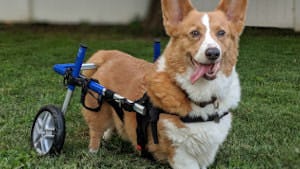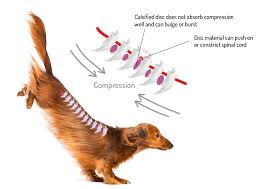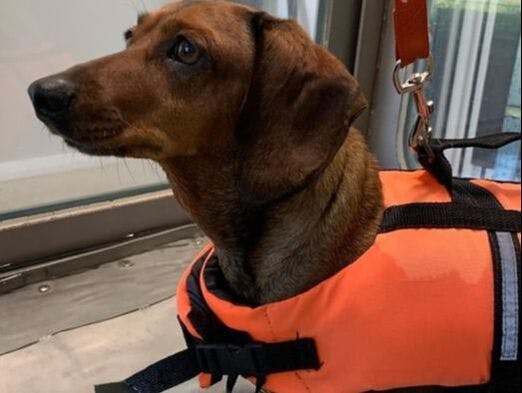Intervertebral Disc Disease in Dogs (IVDD)

It can be devastating when you see your beloved pooch all of a sudden have spinal pain or weakness in their limbs and not be able to move around as well as they used to. This may possibly be IVDD which is Intervertebral Disc Disease. This is a condition often seen in certain breeds, but any dog of age or type can develop IVDD.
IVDD is a disease that effects the spinal cord over time, but it might not be apparent until there is a trigger. Unfortunately, a dog who appears to be completely healthy one day may take a fall, tumble or jump in such a way that a disc becomes ruptured. IVDD is a degenerative (gradual) process, but a jump or fall can damage a disc that has already been weakened by this disease and bring on an acute phase.
Intervertebral discs are cushioning pads of fibrocartilage that sit between most of the vertebra of the spinal column. The discs have an outer layer of tough fibrous tissue and a centre that is more of a gel-like substance. They act as shock absorbers for the bones called vertebra in the spinal column.
Unfortunately, intervertebral discs are subject to degeneration, bulging outward, bursting or rupturing (herniating). When something goes wrong with a disc, the material inside escapes into the spinal column, pressing against the spinal cord or nerve roots, which causes mild to severe pain, nerve damage, neurological issues and sometimes paralysis.
Depending on the location of the damaged disc, problems can occur anywhere in the dog’s body from the neck to the hind limbs. IVDD is one of the most common neurologic disorders seen in dogs. Most aging dogs have some degeneration of intervertebral discs, which commonly results in a condition known as spondylosis which doesn’t progress to intervertebral disc disease.

What Breeds Are Prone to IVDD?
While any dog is prone to IVDD Dogs that are Chondrodystrophic are more susceptible to IVDD. This means certain breeds may have a disorder of their cartilage and bone development and have shorter than normal limbs. IVDD generally occurs in these breeds from 3-6 years of age.
Typical breeds of this type include:
DachshundsBulldogsCorgisPugsFrench BulldogsCocker SpanielsBassett HoundsPekineseBeaglesShih Tzus
Overweight dogs in any breed are very likely to get IVDD
Signs of IVDD
Symptoms can come on gradually or be intermittent or sudden.
Here are some common symptoms of IVDD:
Pain and Stiffness of neck, limbs, or backDragging rear leg(s)Knuckling under when walking or standingCrying or yelping when moving or touchedObvious weakness or painLowered head when standingHunched or arched back or neckIncreased sensitivity to movement or touchReluctance to rise up, move or jumpLameness or Impaired gaitLack of co-ordinationParalysisIncontinence (urinary and/or faecal)Muscle spasms in the neck or backEarly intervention is crucial in order to minimise the possibility of permanent nerve damage so please see your Vet at the first sign.
How Can We Help Prevent IVDD?
If your dog is prone to this disease, then unfortunately it may just suddenly happen but there are some easy things we can do to reduce the risk of IVDD for your dogs:
Keep your dog’s weight down and prevent obesityMinimise jumping and leaping on or off furniture, cars, beds and stairsReduce any kind of high impact activitiesUse a harness when walking to reduce stress on the neck
What To Do If You Suspect Your Dog Has IVDD
You will need your Vet to do an examination and this may include, a neurological examination X-rays, special imaging such as MRI or a CT Scan to be able to pin point the source of the spinal injury.
Your Vet may suggest Conservative Management initially if the injury is mild to moderate but in severe cases Surgery will most probably be advised.
Conservative management (non-surgical) of IVDD is initially preferred which would be crate rest, activity modification, anti-inflammatories and pain management for around 4-8 weeks. After that period your dog could progress to some rehabilitation therapies such as Hydrotherapy and physical therapies to build and maintain strength.
If your dog has to go to surgery as conservative management was not an option or was not successful, then surgery may be done to remove disc material from around the spinal cord. The spine is approached through an incision in the middle of the back and using a special drill, a window is made in the bone of the vertebra immediately above the disc. The disc material underneath the spinal cord can then be gently removed.
Rehabilitation for IVDD
Whether your dog has had surgery or not it is very important to have rehabilitation to re gain function, for better range of motion, strength, stability and coordination for your dog. This will help reduce the risk of it happening again to your dog and will speed on recovery.
If your dog has had surgery your Vet may give you some gentle home exercises to do initially and discuss with you rehab options to achieve optimal recovery such as Hydrotherapy, Osteopathy and physical therapies.
Hydrotherapy for IVDD
Hydrotherapy is wonderful for building strength and regaining mobility function. Our Under-Water treadmill is great for IVDD patients as it uses the resistance of the water to give your dog a good workout without having to bear their full weight. This method helps reignite the connections between the limbs and the brain and retrains the neural pathways to begin working correctly.
Osteopathy for IVDD
Our inhouse Osteopath Dr Samantha Sherrington will be able to assist in restoring movement, reduce any pain or discomfort your dog may be experiencing and aid in the re balance and strengthening of your dog. We have had great results with a combination of Dr. Sam’s treatments along with hydrotherapy for our IVDD patients.

K9 Swim Hydrotherapy and Wellness Centre offers Rehabilitation packages for your dog whether he or she has managed IVDD conservatively or has had surgery. You will need to have your Vet fill out our Vet referral form which you will find on our website and have the all clear by your Vet to start their therapy.
Give us a call on1300 787 064 to discuss your dog’s treatment plan.
